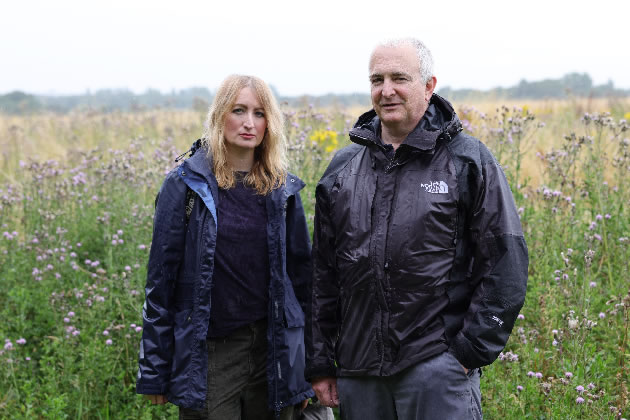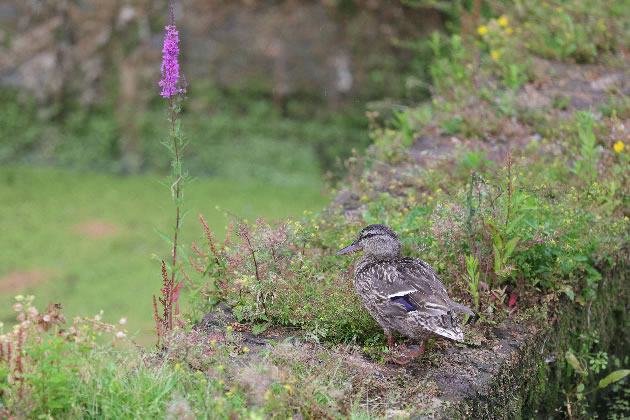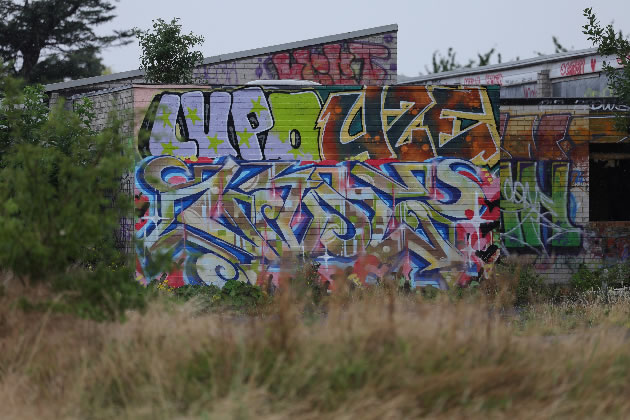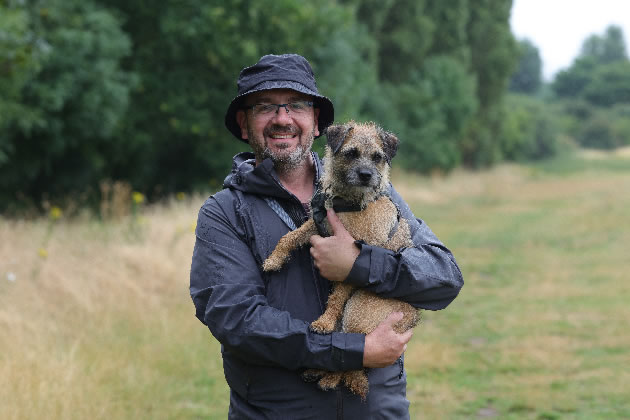Two Sides No Closer to Agreement on Warren Farm
Conservationists and council disagree over plans for sports facility

Katie Boyles and Steve Toft at Warren Farm. Picture: Facundo Arrizabalaga/MyLondon
August 11, 2023
Warren Farm has become the focal point in a row over how best to protect nature while providing residents with what they need. It is now a battleground for conservationists and local authorities ever since councillors agreed to explore the “de-wilding” of a portion of the 61-acre reserve in January.
Ealing Council’s decision to explore plans to create a new sports facility on the overgrown site, while turning an adjacent area into a new wildlife haven has prompted fierce opposition from certain sections of the E community with thousands of locals signing a petition calling for the area to be left alone and continue to provide a habitat for rare fauna and flora. However, this is an uphill battle for campaigners because, despite it being known locally as a nature reserve, this status is unofficial and it has very little in the way of legal protections.
Technically the large area of open space, now filled with wild grasslands home to rare species such as the skylark, is just an unloved and unkempt sports facility. The council’s proposal would see part of the land converted back into eight football pitches and renovation or replacement of the crumbling graffiti-covered changing rooms and decrepit asbestos-filled shower blocks that have been left to deteriorate on the land for over a decade. Meanwhile a patch of pasture would be protected for wildlife, but campaigners argue it’ll take a long time to provide the sorts of important homes the existing ‘nature reserve’ does.
Campaigners Katie Boyles and Steve Toft from the Brent River Trust are concerned with the plans for several reasons. The development, they say, would cut the ‘reserve’ in half, destroying already established breeding grounds, nests and rare plants, potentially driving some of the animals that live there including the skylarks, barn owls and bats out of the area.
“The main bird species here that we are concerned about is the skylarks,” Ms Boyles told the Local Democracy Reporting Service during a tour of the reserve. “They nest on the ground and we have been given two letters of support by the RSPB to say that a quarter of London’s skylark population nests here. The only reason that they do is because the site is so wide and because the grasses and flowers produce enough food and cover for them.”

Warren Farm and nearby canal with duck. Picture: Facundo Arrizabalaga/MyLondon
She says that Ealing Council, by pushing forward with exploring plans to develop the site, are bucking the trend of other London councils by not ensuring the skylarks are protected. “What’s really depressing and sad about is, Richmond have them in the royal parks and the council are doing their utmost to protect theirs including putting up signs, introducing fixed penalty notices, etc. But here our council are doing the complete opposite; they seem happy to let these birds go extinct.”
Activity surrounding the project, including noisy vehicle visits, building waste and sounds could also be disruptive, while clearing such a large space could jeopardise at least 15 locally important plant species that are dependent upon the site, campaigners argue. There are also a number of things that campaigners claim have been poorly communicated or misrepresented by the council in order to make the scheme more tolerable to the public.
The council has said that 62 per cent of the site will be protected by the plans, with roughly a third being used for sports facilities, however, Mr Toft says this is a bit of “mathematical sleight of hand” by local authorities. “It depends on what you mean by a third and where you start from,” he says. “They want to develop half of this [the current land that makes up the ‘nature reserve’] – what they say they are going to do is add the Imperial College land [at the far end of the meadow] to the nature reserve, so if you take the totality of this the bit they want to development is only a third, it’s a bit of mathematical sleight of hand. If you make the area bigger you can say it’s only a third, but it’s actually half of Warren Farm.”
The inclusion of Imperial College land, which the council has agreed on a 99-year lease, is seen as a positive but unlike Warren Farm where acid grasslands and rare species have already established themselves in the past 14 years, the college land, currently separated by heavy-duty fencing, is primarily used for grazing horses.
The council’s plan, as understood by campaigners is to effectively de-wild an area which is already a flourishing wildlife habitat and turn it into short grass playing fields and re-wild land into a flourishing wildlife habitat which is currently short-grass fields.
Ms Boyles says the plans are a compromise that does not work for protecting species like the skylark, leaving the nature reserve as a long, thin strip of land at the bottom of the meadow.
She adds, “There are only 2 per cent of meadow habitats like this across the whole of the UK. There is a climate emergency, there is a biodiversity crisis, 2 per cent of places like this left and they want to cut half of it for astroturf, car parking, things that would be better placed elsewhere.”
Walking around the nature reserve it is hard not to notice the sad-looking cluster of crumbling buildings that make up the old sports complex in the periphery of the land. Ms Boyles says that despite repeated pleas to get the buildings removed they are kept there. “They are horrific. We’ve been asking the council for over 10 years to take them down. There are fires started in there, there’s been drug deals, there’s been needles and stuff like that found. There’s a burst water main that we have to keep calling having to call them out to come and fix, the fire brigade has been called.”
She claimed, “We think the council likes to keep them [the buildings] here because it fulfils their rhetoric that it was once for sport.”

Run down buildings, Warren Farm. Picture: Facundo Arrizabalaga/MyLondon
With a petition 22,000 signatures strong in opposition to plans and hundreds protesting the decision to develop the land outside the council building back in February, it is no surprise that optics play a role in the debate. Beyond just the animals and plants, Warren Farm evidently already acts as a place where people exercise.
One of the big justifications for pushing the plans forward was to do with health inequalities in Southall. As Deirdre Costigan, cabinet member for climate action and deputy leader of the council, said at the time plans were announced, “We are very aware that nearby Southall has the highest rates of ill health and disability in our borough. It is also very densely populated, with an acute shortage of space for playing fields. Southall residents are missing out on vital facilities that could help challenge the serious health inequalities they face. We have a duty to residents to address this, while also balancing this with our commitment to rewilding the majority of the site.”
However, even in the face of pouring rain dog walkers, joggers and runners were all using the well-established network of paths through the grasses when the LDRS visited.
Dog walker Matthew Tabern describes Warren Farm as “an oasis in the middle of London”. He said he has signed the petition opposing changes to the meadow but accepts that residents like him have been lucky to have a place like the nature reserve for so many years.
“Obviously it was used as school pitches for years and years and years but then they obviously decided that they could no longer fund that, but now it’s so established as a wildlife reserve, I mean, the amount of different species here is incredible and to flatten it just seems criminal to me.”
He adds that he would still bring his dog to the area even if plans do go through. “I think I would yeah. Having this as a facility when you live in London, you just have to walk over the canal, it feels like we have been spoilt and have been for a long time.”

Matthew Tabern and dog. Picture: Facundo Arrizabalaga/MyLondon
Addressing the council’s idea that the area could serve as a spot for Southall residents to get fit he added, “That sounds very unlikely, I’m not even sure if there is a bus route that comes down here [from Southall].” He added, “It’s really not that nearby, when the kids used to come down here they came by coaches and parked in the car parks that were here. I think that’s a bit of a desperate reason – to turn it into an open-air fitness environment for Southall residents, sound spurious.”
Another dog walker, Tim Robinson, said he had concerns with both parties’ plans. He says he fundamentally likes Warren Farm the way it is, “It’s a difficult one because I like it as it is and I don’t really want it to change.”
However, as someone who has used the area for years, he sees both the council and the conservationists’ plans as interfering with the peaceful pocket of London, he has almost to himself. “I remember when it was a functioning sports centre and then when it closed down, nobody used to come over here, you’d maybe meet one other dog walker. Now with the skylarks you have people shouting at you to keep your dog on your lead, there has been a bit of kickback against people who have used it historically. So, people are a bit worried that if it becomes an official nature reserve, they might have dogs on leads, so there’s that. That’s my primary worry.”
While the debate rages, particularly amongst impassioned people online, the council says its goals and aims in developing the site have not changed in the past seven months, however nothing, as of yet, is set in stone. A council spokesperson said, “The council needs to balance the needs of all our residents and our approach has been to achieve a compromise that delivers both a new nature reserve and much-needed football and cricket pitches for local residents.
“We know that not everyone is going to agree. But we also know that we are all going to need to make some compromises if we are going to both to protect and preserve nature, and to bring back into use the sports pitches that young people in Southall urgently need.
“Nothing is yet set in stone, and we have commissioned detailed nature and ecology surveys to help inform the next steps of this project. We will continue to work with local groups and community stakeholders as we make this a reality.”
Rory Bennett - Local Democracy Reporter